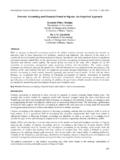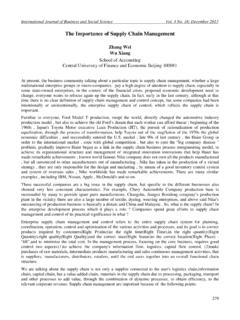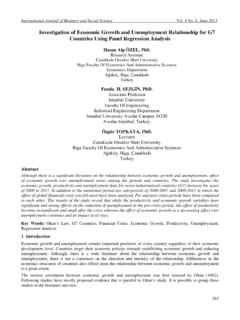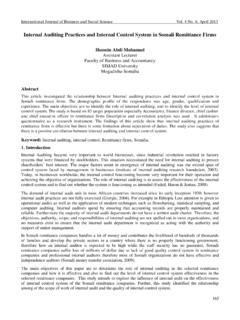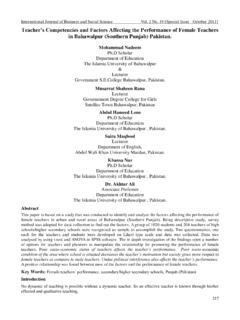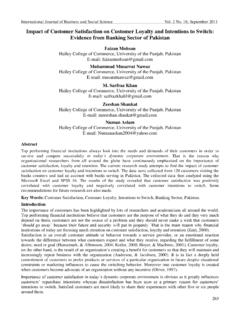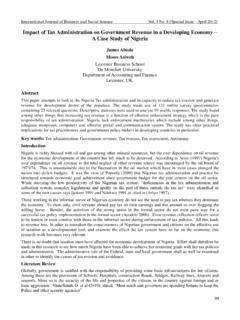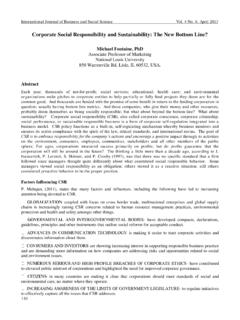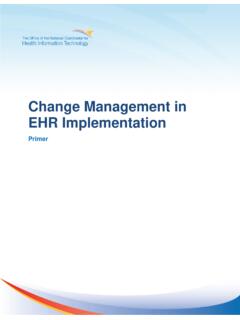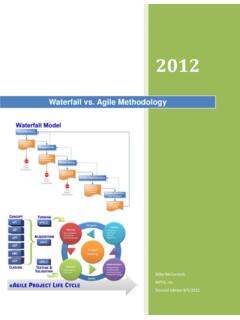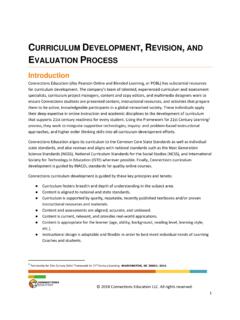Transcription of Impact of Discussion Method on Students Performance
1 International Journal of Business and Social Science Vol. 2 No. 7; [Special Issue April 2011] 84 Impact of Discussion Method on Students Performance Dr Fazalur Rahman Lecturer Department of Early Childhood Education & Elementary Teacher Education Allama Iqbal Open University (AIOU) Islamabad E-mail: Jaddi khan khalil Senior English Teacher Government Higher Secondary School No 4 Peshawar Prof Dr Nabi Bux Jumani Professor, Department of Education, International Islamic University(IIU) Islamabad E-mail: Dr Muhammad Ajmal Lecturer, Department of Distance, non formal & continuing Education Allama Iqbal Open University (AIOU) Islamabad E-mail: Dr Samina Malik Assistant Professor, International Islamic University(IIU) Islamabad Muhammad Sharif Principal Oxford Model Public school Rawalpindi Pakistan Abstract Teaching is an art of assisting Students to learn.
2 All good teaching is characterized by proper teaching Method . This study was undertaken to investigate the effectiveness of teaching methods in the subject of social studies. The study was experimental in nature and a pretest/posttest control group design was used. The sample of the study consisted of 62 Students of grade 10th. The Students were grouped into control and experimental groups equally. Both groups were pre-tested. Two teaching methods ( Discussion and lecture Method ) were used in the study. The experimental group was taught with Discussion Method along with lecture while the control group was taught with lecture Method only. Four lessons were selected in the subject of social studies. Duration of each period was 45 minutes.
3 The experiment was continued for one month. Pretests and Posttests were developed for each topic. The results of pre-tests revealed that there was no significant difference in the Performance of both groups. While the results of post-tests revealed that there was significant difference in the mean score of both experimental and control group. The results of the study indicated that mean score of the experimental group was higher than the control group. It was concluded that Discussion Method was more effective than lecture Method . The study recommended that teachers may prefer Discussion Method in teaching of social studies. Key words: Discussion Method ; lecture Method , social studies; experimental study.
4 Introduction Social studies are taught in Pakistani school under the title of Pakistan studies at secondary level. It is taught in schools as a compulsory subject from secondary level to degree level. However, it is taught under the title of social studies from class first to class eight. Almost all the universities are offering the subject at advance level. Pakistan is an ideological state. There is diversity in cultural, ethnic, and social aspects in various communities inhabiting the country. Pakistan studies is taught in our schools by different teaching methods such as lecture Method , Discussion Method , text book Method , project Method , study tours, problem solving Method , team teaching, inquiry approach etc.
5 Lecture Method is most widely used Method whole Discussion Method has the potential to bring about a positive change in the teaching of Pakistan studies. The Special Issue on Contemporary Issues in Social Science Centre for Promoting ideas , USA 85 However, it is the teacher who selects the strategy according to the needs of Students . Nayak & Singh (1997) described that a best scheme of education becomes a bad scheme if the teachers handling it are bad; even so a bad scheme can, in practice, be made a good one, if the teachers are good. Teaching methods are patterns of teacher behavior that occur either simultaneously or in sequence in a verified way. Choosing specific teaching methods that best achieves course objectives is one of the most important decisions a teacher faces.
6 Knowing what methods are available and what objectives each Method is best suited for, help teachers make this decision more easily. Most people, when asked about teaching methods , start by identifying two main types of instruction-lecture and Discussion -which are on the opposite ends with many exciting possibilities in between. The coming paragraphs described both lecture and Discussion methods in details: Joseph (1998, p. 5) says that lecture Method is basically narration that will signify what we usually call explanation or description. A lecture is a narrative technique of delivering verbally a body of knowledge according to pre prepared scheme of action as cited by International Dictionary of Education (1991). According to it, in lecture Method fact or principle is presented orally to groups of Students who take notes, have little or no participation in learning, and experience passive rather than active learning.
7 The lecture technique should not be confused with the supplying of information by the teacher. According to Walker (2002) there are three main reasons to use the lecture format: 1. To transmit information, 2. To create interest, 3. To promote understanding According to Moore (1999) lecture can be used to effectively survey the structure of knowledge in a particular area as well as suggest the connection between cases and real decision-making, reaches Students at an emotional level, and provides necessary motivation for learning difficult material. Good lectures have certain qualities that determine the effectiveness of the Method . Lectures can be good or bad depending on these qualities. The effectiveness of a Method can be determined by studying the degree to which its objectives are achieved.
8 IUB (2001) has described the following objectives of lectures: 1. Exercising/gaining control of the class 2. Highlighting major ideas 3. Setting the stage for forthcoming activities 4. Showing one's own interest for the subject 5. Providing a model of good communication skills. There are different types of lecture Method as described by Kumar (2003), GSU Master Teacher Program (2003) and Lieux (1997): 1. The expository lecture: It is what most Students think of when they hear that the teacher lectures a lot. The instructor does most of the talking and at times allows Students to ask questions of clarification. 2. illustrated lecture: It can take up different forms for example; transparencies, filmstrips, slides, projected and non-projected pictures, diagrams, maps, charts, and blackboard writings.
9 These are meant to catch the attention of the learners and must be prepared carefully. They must be visible to the audience and the audience should know the relevance of the illustration. Illustration become part of the lecture when they are well planned well prepared and well presented. 3. The Lecture Recitation: In this teacher does most of the talking, but often stops and asks Students specific questions or requests Students to read prepared material. In the lecture - recitation, the direction of interaction is either teacher to class, teacher to individual student, or individual student to teacher. 4. Lecture-cum- demonstration : This type of teaching serves a positive purpose as the Students keen observation during demonstration enables them in comprehension.
10 Demonstrations are often useful when concepts are being developed. It is helpful in teaching of skill-subjects, sciences and languages. Lecture cum demonstration is suited particularly to the Students who have limited ability to think abstractly. 5. The interactive lecture: It encourages student-to-student interaction. In this the instructor begins with a 15 to 25 minute mini-lecture and then asks the Students to form learning groups and complete an assignment based on the mini-lecture. 6. Lecture cum buzz sessions: In this process the whole class is divided into small groups (five to ten Students ) after the lecture is delivered. For few minutes (usually five minutes) buzz session is organized on particular aspect of the lecture.
